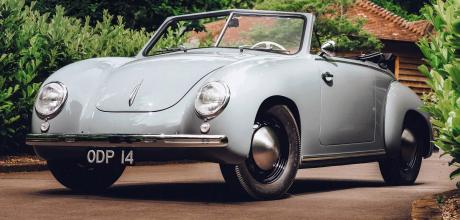1950 VW Sportkabriolett Dannenhauer & Stauss
Built on Porsche 356 running gear, this Sportkabriolett is the car Dannenhauer & Stauss had always dreamed of creating.
WORDS CHARLIE CALDERWOOD
PHOTOGRAPHY MAX EDLESTON
SEVENTY YEARS IN THE MAKING
THE PEOPLE’S SPEEDSTER
Delving into the history of the rare VW Dannenhauer & Stauss Sportkabriolett
You can’t keep sports cars down for long. From the ruins of war, various coachbuilders in Germany and Austria were building roadsters and coupés on the running gear of the relaunched Volkswagen by 1950. Porsche had hired Reutter of Stuttgart to build bodies for the 356, having taken two years to create the first 50 by itself in Gmünd, Austria.
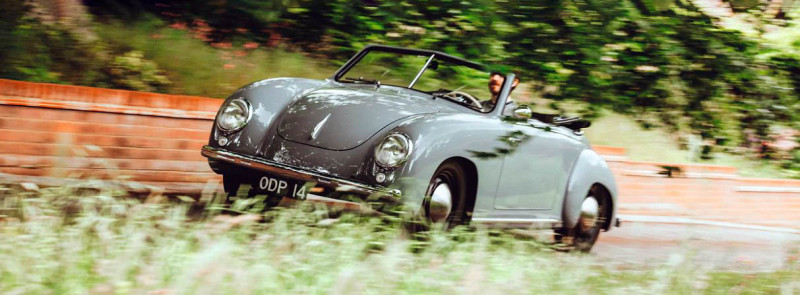
Making such cars at a lesser rate – although not drastically so – was Dannenhauer & Stauss. Having worked on the bodies of the KdF Wagen prototypes with Reutter before the war, Gottfried Dannenhauer knew how to take apart a Beetle better than most. With the new Federal Republic of Germany founded in May 1949, Dannenhauer could see a return to normality and, with that, demand for a drop-top sports car based on the ubiquitous and well-supported Volkswagen. Son-in-law Kurt Stauss, also an accomplished panel beater and mechanic, joined the venture, and the pair set up shop in Stuttgart.
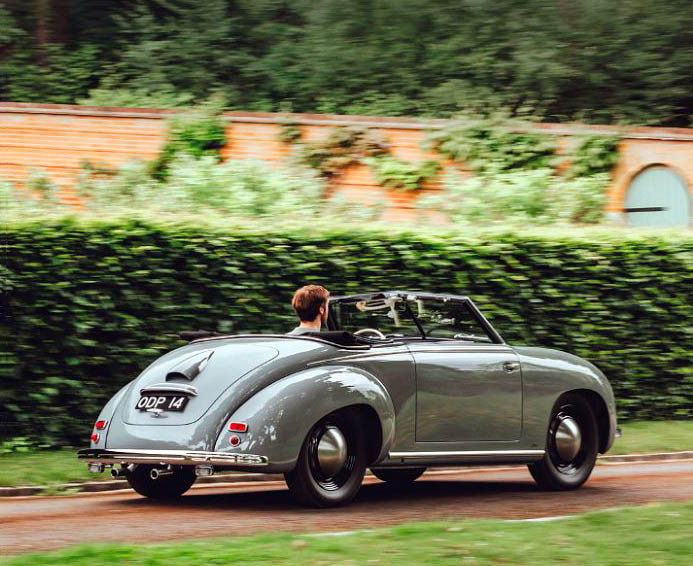
The two metalworkers were wise enough not to attempt designing the car themselves, so they enlisted the help of two students of Wunibald Kamm (of ‘Kamm tail’ fame) to style the body. The pair, herren Oswald and Wagner, had already been working on a prototype, and this provided the basis of the D&S. Dannenhauer and Stauss made a few adjustments, though, chiefly the removal of a luggage compartment with a locking lid sited between the engine and the passenger compartment. Their car would have a basic bench that could double as cargo space or emergency rear seats instead, with the first Sportkabriolett built by Christmas 1950.
‘The most obvious appeal of The D&S today is as one of the rarest cars in the air-cooled Volkswagen pantheon’
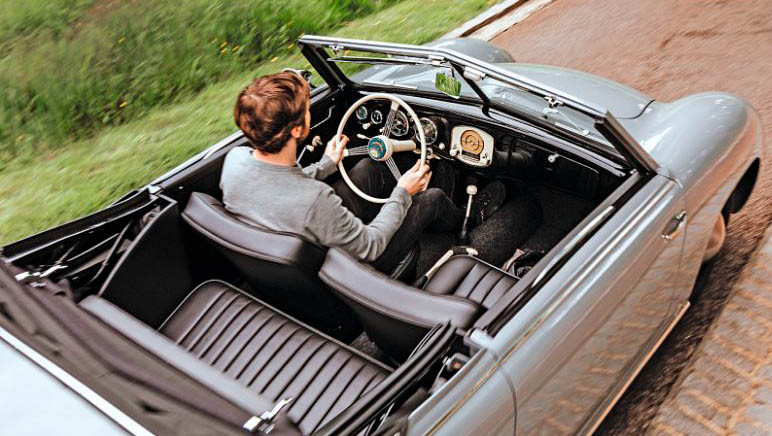
The car with us today was completed in late 1951, and is as the Sportkabriolett originally appeared, the split-windscreen being the most obvious marker of its vintage. The front has no small amount of resemblance to the Porsche 356 (it’s hard to avoid with a car that shares so many fundamentals), but the D&S is noticeably more upright, having carried over the Volkswagen’s ‘skateboard’ platform rather than switching to a more integrated unitary construction as Porsche did. The side profile is much more distinctive, however. The influence of its aerodynamicist designers is clear, the car being essentially a halfellipse with wheels, slightly higher at the front than the back. It’s sleek, but in a less sporting and more graceful way than the Porsche. Detailing is minimal, although the rear carries probably the most distinctive single element: a ground-facing, nose-shaped air intake on the engine hatch.
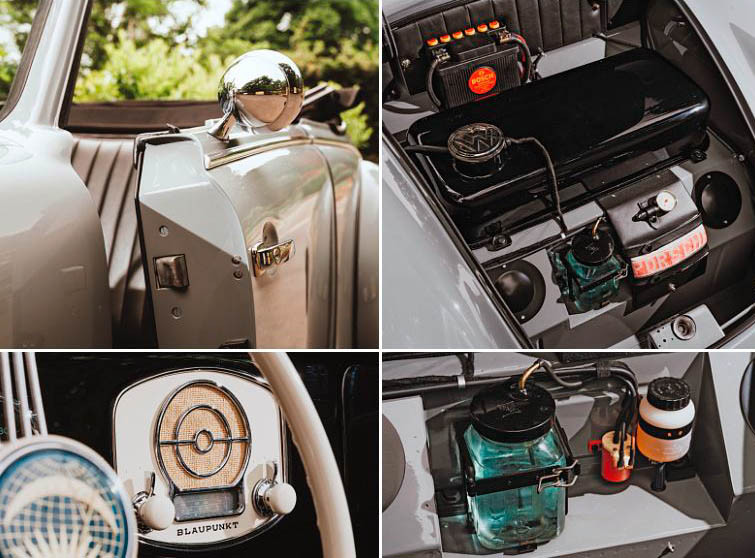
D&S faced a constant struggle to source chassis for its cars – Volkswagen wasn’t just selling them out the back of the Wolfsburg works. VW dealers outside Germany were among the best sources, with D&S buying them from as far afield as Sweden. This car was built from a 1950 Beetle that would have been a year old when it arrived at D&S, suggesting that the customer supplied the car or it was a salvage job. Its history, however, is a complete mystery from then until it was found, dilapidated, in Vienna in 1980. Local Rudolf Ettel identified the D&S after being invited to look at the car, which its owner assumed was some kind of early Porsche. Ettel bought the car and restored it, painting it white, and owned it for the following 38 years, even taking it on the 1989 Targa Florio.
Ettel sold the D&S to a German dealer in 2018, and that’s when Mark Reynolds, owner of British air-cooled VW camper parts supplier Just Kampers, saw the car. It took protracted negotiations to acquire it; at one point Reynolds gave up before his offer was reconsidered several months later. It was the fulfilment of an ambition decades in the making for Reynolds, the D&S being the car that dominated his photo reel after his first visit to VW’s Wolfsburg museum some 30 years earlier. He is one of Britain’s leading figures in the air-cooled world and has owned more than 200 Volkswagens and Porsches since then, sampling nearly every variant of air-cooled VW in that time, but this is his first D&S. There are only 19 confirmed extant cars.
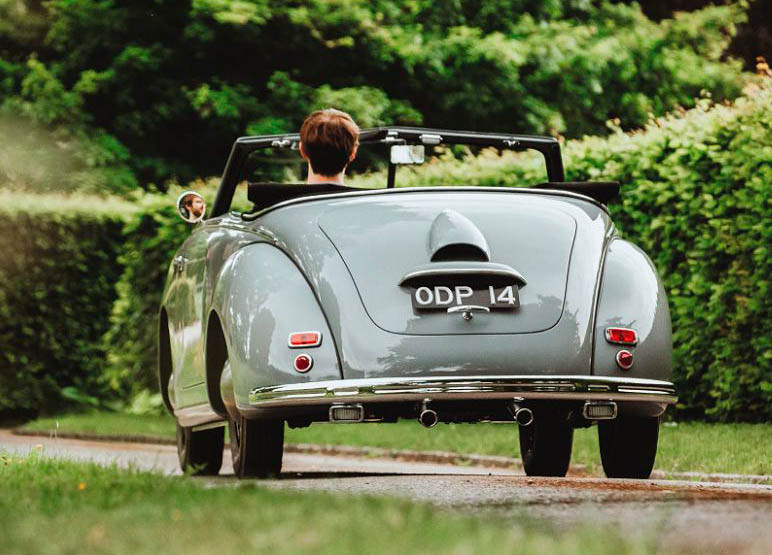
Reynolds not only bought the car but also visited the D&S workshop in Stuttgart, which is still in business today as an accident-repair shop, now in the hands of Gisela Stauss, daughter of Kurt. Thrilled to find someone so interested in the history of the firm, Stauss gave Reynolds an original D&S workshop sign, the remains of a wooden block used for panelbeating, and a model of a grey D&S Sportkabriolett with a black interior – the specification that her father had often told her was the car he always wanted to build, on top of Porsche 356 running gear.
Gisela’s gift wasn’t intended as a throwing down of the gauntlet, but as Reynolds spent more time with his D&S and realised that a full restoration was going to be on the cards, it became clear that there was only one way he could go.
Like nearly all D&Ss, Reynolds’ car was originally fitted with a VW engine. Some tuning was offered along with the conversions, but most buyers stuck with the standard 30bhp. Reynolds purchased a CTR beach buggy that had been built on 1955 ‘pre-A’ 356 running gear, to source all the Porsche componentry and make the car that Stauss had described to him, while the body of the D&S was restored by FH Ellis Coachworks, opposite Just Kampers’ workshop.
The heavily lead-loaded bodywork was in relatively good condition, but the chassis was bent, shorter on one side than the other, so this was replaced (Reynolds still has the original, now acting as a bookshelf in his garage). The beach buggy also donated the Porsche dials that now grace the Sportkabriolett, which required slight modification of the dash – although this echoed the D&S approach, building its dashboards from modified VW and Porsche pieces.
Painted in grey and trimmed in black Connolly leather, the D&S Sportkabriolett is finally as Kurt Stauss had once imagined. Its freshly rebuilt 356 transmission is still very stiff because they take unusually long to bed in but, gearbox negotiated, the car has considerably more urgency than a contemporary Beetle – and, presumably, other D&Ss. Its 46bhp isn’t much, but it’s a 53% increase on the Volkswagen engine and enough to pull the 778kg Sportkabriolett at a rate that’s leisurely – but not uncomfortably so – on UK roads. To steer, the car is much as a Beetle and therefore charming if not dynamically impressive. Braking is again from the 356 and strong for a drum set-up. This is the one area where Reynolds has deviated from the D&S formula – not to increase braking power, but adding a dual-circuit master cylinder set-up from a 1970s Beetle for safety, hidden under a lifting metal panel in the front boot.
This car, though, is all about its bodywork, resplendent in 1950s grey. The suicide doors, held in place by just a roller latch rather than a proper safety catch, and thus deserving of their name, shut like a bank vault. No slamming is needed: just the gentlest push has it clicking into place. Almost as satisfying are the front and rear hatches. Operated by an under-dash pull at the front and a locking handle at the rear, both are held open by automatic latches once raised to their full height.To close, lift slightly to unhook the latches and the hinges let the piece drop – an elegant operation that fits the car’s appearance. Both details are the sort you only find on cars built in such small volumes in this era. These simple but high-quality touches demonstrate the D&S’s character and show what was most valuable to German buyers in the early 1950s. The Sportkabriolett offers little luxury or performance, but everything is designed in the most thorough way and built exquisitely. This is further seen in the hood, which raises and lowers in one smooth movement and simply latches to the ’screen surround – laughing in the face of countless considerably younger British roadsters that demand minutes of roof-wrangling. For Dannenhaur and Stauss themselves, however, this bloody-minded devotion to build quality and engineering purity was ruinous.
Working with no more than 20 employees, D&S built its cars in a slow, intensive manner. A 1:1-scale wooden buck was built by the pair, on which every panel was formed. There wasn’t a single pressing on the entire car, with the doors and both boots formed as single pieces and everything else made from sheet sections welded together. Each car took 800-1000 hours to build, with Dannenhauer and Stauss themselves working long into the night and earning so little from the process that they couldn’t even afford to keep one of their own creations. So busy was the pair that little documentation was created and thus the number of D&Ss built is unknown. Somewhere between 80-135 is the estimate, with the arrival of the Karmann Ghia effectively killing off the Sportkabriolett in 1955.
Built in low numbers and for only a short time, the D&S’s most obvious appeal today is as one of the rarest cars in the air-cooled Volkswagen pantheon. Reynolds’ car is one of five surviving split-screen cabriolets; later examples had curved windscreens, while a couple of fixed-head coupés were also built. It’s a ticket to standing out in the VW scene, where a bright-purple Beetle with a V8 hanging out the back no longer bats an eyelid.
For Reynolds, however, the Sportkabriolett is a window into a unique and short-lived time when many cities within the German-speaking world had local coachbuilders creating their own VW-based cars. No true enthusiast would begrudge Porsche’s success, nor the creation of the Karmann Ghia, but it seems a shame we’re unlikely to ever see a similar era again.
Thanks to Just Kampers (01256 862288; justkampers.com)
From top: each Sportkabriolett took up to 1000 hours to build in the D&S workshop; an original English-language handbook; early D&S press shot Gisela Stauss gave an original D&S workshop sign to Reynolds; it now hangs over the restored car in his garage.
A ‘pre-A’ Porsche 356 engine makes this one of the fastest D&Ss built. Most had standard VW units.
The D&S is, unsurprisingly, much like a Beetle to drive, but its 46bhp adds some welcome extra urgency.
Simple but high-quality period details remain throughout. Left: black, leather-lined flap covers a more modern dual circuit brake cylinder, added by Reynolds for improved safety


